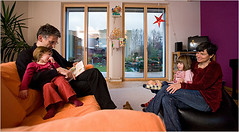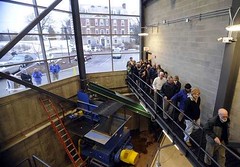
At the very top of the popularity list of e-mailed articles at the
New York Times three days afters its initial posting,
No Furnaces but Heat Aplenty in 'Passive Houses' is an instructive lesson in solving energy problems in a non-traditional way. Journalist Elisabeth Rosenthal describes an innovative approach to building design, focusing on the "passive house" of a German family that maintains comfortable temperatures throughout the winter even though it has no furnace. The trick? Ultrathick insulation, a unique ventilation system, and similar design advances that essentially recycle heating.
It's a technique that has been tried, but was marked by failure in the past.
Decades ago, attempts at creating sealed solar-heated homes failed, because of stagnant air and mold. But new passive houses use an ingenious central ventilation system. The warm air going out passes side by side with clean, cold air coming in, exchanging heat with 90 percent efficiency.
“The myth before was that to be warm you had to have heating. Our goal is to create a warm house without energy demand,” said Wolfgang Hasper, an engineer at the Passivhaus Institut in Darmstadt. “This is not about wearing thick pullovers, turning the thermostat down and putting up with drafts. It’s about being comfortable with less energy input, and we do this by recycling heating.”
There are now an estimated 15,000 passive houses around the world, the vast majority built in the past few years in German-speaking countries or Scandinavia.
This isn't an approach that I hear discussed often in the U.S., which is perhaps why there was such a tremendous amount of interest in the article at the
New York Times. Unlike other forms of alternative energy at the residential level, which can cost tens of thousands of dollars to deploy, passive houses in Germany cost approximately 5 to 7 percent more to build than a conventional home. This technique definitely bears more investigation. Sometimes the solutions to the most vexing energy problems are right before us, but overlooked in the rush toward flashier, higher technology solutions.


